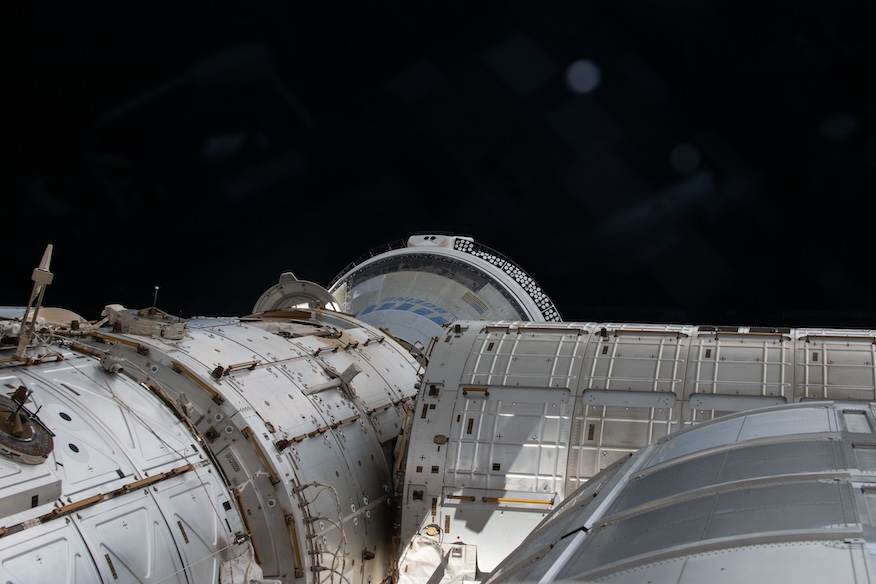NASA Space Technology

The return to Earth of Boeing’s Starliner capsule is on indefinite hold pending results of new thruster tests and ongoing analysis of helium leaks that cropped up during the ship’s rendezvous with the International Space Station, NASA announced Friday.
But agency officials insisted Starliner commander Barry “Butch” Wilmore and co-pilot Sunita Williams are not “stranded” in space.
“We don’t have a targeted (landing) date today,” Steve Stich, NASA’s Commercial Crew Program manager, told reporters during a teleconference. “We’re not going to target a specific date until we get that testing completed.
“So essentially, it’s complete the testing, complete the fault tree, bring that analysis into (the mission management team) and then have an agency-level review. And then we’ll lay out the rest of the plan from undock to landing. I think we’re on a good path.”
The problem for NASA and Boeing is that the Starliner’s service module, which houses the helium lines, thrusters and other critical systems, is discarded before re-entry and burns up in the atmosphere. Engineers will not be able to study the hardware after the fact and as a result, they want to collect as much data as possible before Wilmore and Williams head home.
But the crew’s repeatedly extended stay at the space station has prompted some observers to say Wilmore and Williams are stranded in orbit, an impression that seems to have taken root in the absence of updates from NASA as the target landing date was repeatedly pushed back.
Stich and Mark Nappi, Boeing’s Starliner program manager, said that description is a mis-characterization.
“It’s pretty painful to read the things that are out there” Nappi said. “We’ve gotten a really good test flight … and it’s being viewed rather negatively. We’re not stuck on ISS. The crew is not in any danger, and there’s no increased risk when we decide to bring Suni and Butch back to Earth.”
Said Stich: “I want to make it very clear that Butch and Suni are not stranded in space. Our plan is to continue to return them on Starliner and return them home at the right time.
“We’ll have a little bit more work to do to get there for the final return, but they’re safe on space station. Their spacecraft is working well, and they’re enjoying their time on the space station.”
The Starliner was launched June 5 on the program’s first piloted test flight with one already known helium leak. The other four developed during the ship’s rendezvous with the space station when the jets were rapidly pulsed to fine tune the Starliner’s approach.
While docked at the station, valves are closed to isolate the helium system, eliminating any additional leakage. But once Wilmore and Williams depart and head for home, the valves will be re-opened to repressurize the lines, or manifolds.
Stich said even with the known leaks, the spacecraft will have 10 times the amount of helium it needs to get home. But engineers want to make sure the leaks won’t get worse once the system is again pressurized.
The five aft-facing thrusters in the Starliner’s service module also failed to operate properly during approach to the space station on June 6.
After docking, four of the five jets were successfully test fired and despite slightly lower power levels than expected, they are considered good to go for undocking and re-entry. The fifth thruster was not “hot fired” because it’s earlier performance indicated it had actually failed.
But managers want to find out what caused the unexpected behavior in the other four. Starting next week, a new thruster identical to the ones aboard the Starliner will be test fired at a government facility at White Sands, N.M., exactly like the those in orbit were fired during the Starliner’s rendezvous and docking.
“We’ll recreate that profile,” Stich said. “Then we’ll put a pretty aggressive profile in the thruster for (the undocking-to-re-entry) phase.
It’s possible the glitches with the aft-facing thrusters were caused by higher-than-normal temperatures due to the Starliner’s orientation with respect to the sun, or the sequence of rapid, repetitive firings commanded by the flight software. Or both.
The ground tests, expected to last “a couple of weeks,” may provide evidence one way or the other.
“This will be a real opportunity to examine a thruster just like we’ve had in space on the ground, a detailed inspection,” Stich said. “Once that testing is done, then we’ll look at the plan for landing.”
As for the impression the crew is stranded in space, Stich and Nappi both pointed out that on Wednesday, a defunct Russian satellite in a slightly lower, more tilted orbit than the space station suffered a catastrophic “event” that produced more than 100 pieces of trackable debris.
While flight controllers evaluated the trajectories of the wreckage, the space station’s nine-member crew was told to “shelter in place” aboard their respective spacecraft, ready to immediately depart and return to Earth in case of a damaging impact.
Two Russian cosmonauts and NASA’s Tracy Dyson boarded their Soyuz ferry ship while three NASA astronauts and another cosmonaut floated into their SpaceX Crew Dragon. Wilmore and Williams rode out safe haven inside the Starliner and were cleared to fly home if warranted.
After about one hour, the crew was given the all clear to return to normal work. Had the Starliner had been considered unsafe, Wilmore and Williams likely would have been told to seek refuge in the Crew Dragon. But that was not the case.
“We have an approval to be a lifeboat in case of an emergency on ISS,” Nappi said. “That means we can return with the Starliner at any time, and that was proven this week.”
Discover more from Tamfis
Subscribe to get the latest posts sent to your email.








